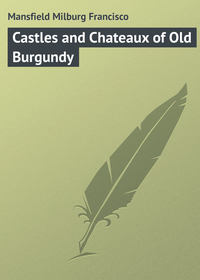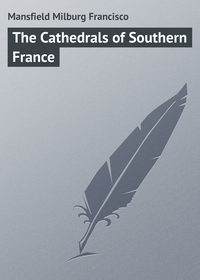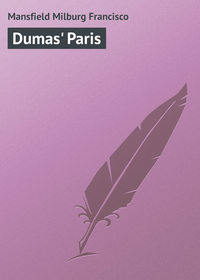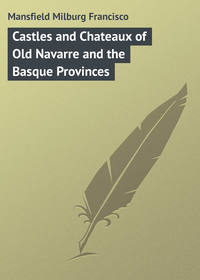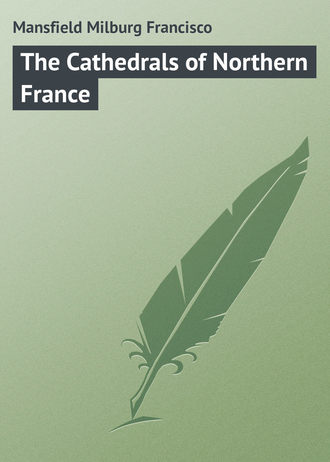 полная версия
полная версияThe Cathedrals of Northern France
The lower portion of the northwest tower, called the Tour St. Romain, is all that is left of the eleventh-century building, the remainder of which was destroyed by fire in 1200. Rebuilding followed in succeeding years and shows work of many styles. Additions, repairs, and interpolations were incorporated with the fragment of the tower, so that the structure as we now know it stood complete with the early thirteenth century. Viollet-le-Duc is the authority for the statement that the apse and transept, chapels, choir, and two doorways of the west façade were quite complete before the influence of the perfected Gothic of the Isle of France was even felt. One Enguerrand was the chief designer of the new church, assisted by Jean d'Andeli as master mason. The early century saw the nave chapels built, having been preceded by the Portail aux Libraires, a sort of cloistered north entrance, still so referred to, one of the most charming and quiet old-world retreats to be found to-day even within the hallowed precincts of a cathedral. The Portail de la Calende did not follow until a century later, when the Tour St. Romain was completed to its roof; at which time was also added the screen or arcade which separates the Portail aux Libraires from the street.
This century, too, saw the beginning of the famous Tour de Beurre, built mostly by the contributions of those who paid for the indulgence of being allowed to eat butter during Lent. Its foundation was laid in 1487 under Archbishop Robert de Croixmore, and it was completed under Cardinal d'Amboise in 1507. A chapel at the base of the tower is dedicated to St. Stephen. The ornate decorations of the west front, added by Georges d'Amboise, are mainly of the sixteenth century and form no part of the original plan or design. It borders upon the style we have since learned to decry, but it is, at least, marvellous as to the skill with which its foliaged and crocketed pinnacles and elaborate traceries are worked. Ruskin was probably right in this estimate at least, – "The central gable is the most exquisite piece of pure flamboyant style extant." At the present day this west front is undergoing such restoration and general repair that the entire gable, rose window, and part of the flanking towers are completely covered with a most hideous array of scaffolding.
The central spire as it exists to-day, in reality an abomination of abominations, is naturally enough admired by all when first viewed from afar. It certainly looks not dwarfed, or even fragile, but simply delicate, and withal graceful, an opinion which ultimate association therewith speedily dispels. It must be one of the very first examples of modern iron or steel erection in the world, dating from 1827, following three former spires, each of which was burned. The architect responsible for this monstrosity sought to combine two fabrics in incoherent proportions. More than one authority decries the use of iron as a constructive element, and Chaucer's description of the Temple of Mars in the Knight's Tale reads significantly:
"Wrought all of burned steel…Was long and straight and ghastly for to see."The great part of the exterior of this remarkable church is closely hidden by a rather squalid collection of buildings. Here and there they have been cleared away, but, like much of the process of restoration, where new fabric is let into the old, the incongruity is quite as objectionably apparent as the crumbling stones of another age. Notre Dame de Rouen is singularly confined, but there seems no help for it, and it is but another characteristic of the age in which it was built, – that the people either sought the shelter of churchly environment, or that the church was only too willing to stretch forth its sheltering arms to all and sundry who would lie in its shadow.
In an assignment of ranking beauty to its external features, the decorative west front must manifestly come first; next the Portail aux Libraires, with its arcaded gateway and the remains of the booksellers' stalls which still surround its miniature courtyard; then, perhaps, should follow the Tour St. Romain and the Portail de la Calende, with its charmingly recessed doorway and flanking lancet arches. The sculptured decorations of all are for the most part intact and undisfigured. The gable of the southern doorway rises pointedly until its apex centres with the radiated circular window above, which, by the way, is not of the exceeding great beauty of the other two rose windows, which rank with those at Reims and Chartres as the beaux ideals of these distinctly French achievements.
The interior, viewed down the nave, and showing its great length and that of the choir, impresses one with a graver sense of unity in the manner of building than is possible to conceive with regard to the exterior. The height and length both approximate that of St. Ouen, and, though the nave rises only to ninety-eight feet, an effect of greater loftiness is produced by the unusual quadripartite range of openings from pavement to vaulting: two rows of arches opening into the aisles before the triforium itself is reached. The lantern at the crossing supports the ironwork spire, and admits light to the centre of the church, only to a small degree, however. The south transept, like that of the north, with its ample double aisles, is of great width, and, were the framing of the great rose window of less angularity, it would indeed produce a remarkable effect of grandeur. The other windows, and the arcading of the triforium, are singularly graceful; not lacking either strength or firmness, though having no glass of great rarity or excellence. In this transept is the altar of St. Romain, a seventeenth-century work of little pretensions.
The north transept contains two features which give it immediate precedence over any other, when viewed from within: its gracefully traceried rose window and fine glass, and the delightful stone staircase leading to the chapter library. Mere description cannot do this stairway justice. Renaissance it certainly is, and where we might wish to find nothing but Gothic ornament, it may prove somewhat of a disappointment; but it is magnificent. Its white marble balustrading gleams in the strong light thrown from the western transept window and gives an unmistakable note of richness and sonority. It was built late in the fifteenth century under orders of Cardinal d'Estonteville. The upper doorway leads to the treasury, and that of the first landing to the chamber in which were formerly kept the bibliographical treasures, now housed in the special building which forms the western wall of the outside court.
The north and south aisles of the nave are broken into by a series of chapels, the chief of which are the Chapel to St. Stephen in the base of the Tour de Beurre and du Petit St. Romain, where an abbé or curé speaking the English tongue is often to be found. On the south side is a chapel containing the tomb of William Longsword, second Duke of Normandy, and son of Rollo.
The great attraction of the choir, far more than its beauties of architectural forms, shown in its graceful columns and deep graven capitals, will be, for most visitors, its array of elaborate monuments, including those of Pierre and Louis de Breze, of whom the former, the Grand Seneschal of Normandy under Charles VII., fell at Monthery, and was buried here in 1465. More pretentious is the tomb of Louis, his grandson, erected by his wife Diane de Poitiers, with a significant inscription which the curious may be pleased to figure out for themselves. This noble monument is one of those examples hesitatingly attributed to Jean Goujon. The pièce de résistance is the Renaissance tomb of the Cardinals d'Amboise. Georges I. was memorialized in 1556 by his nephew Georges II., who in turn came to share the same tomb. Both their kneeling figures are beautifully chiselled, and the whole erection is gorgeously representative of the late sixteenth-century monumental work, little in keeping with the Gothic fabric which houses it, but characteristic of the changing thought and influence of its time. Six symbolical figures of the virtues form a lower course, while the canopy is surmounted by nineteen figures of apostles, saints, etc. In 1793 the ashes of these great prelates were scattered to the winds, but the effigies and their setting fortunately remained uninjured. Other archbishops of the cathedral are buried in the choir, and the heart of Richard Cœur de Lion once rested here, as did also the bodies of his brother Henry, and John, Duke of Bedford.
The choir stalls, mostly the work of Flemish wood-carvers, are notable examples.
V
BASILIQUE DE ST. DENIS
The Basilica of St. Denis, so-called to-day, built over the remains of the martyred St. Denis, is in a way the counterpart of the Cathedral of Reims, in that it also is intimately associated with the Kings of France. In the former they were, almost without exception, crowned; and here, at St. Denis, are the memorials of their greatness, and in many cases their actual tombs. Thus far and no farther may the similarity be said to exist. The old Abbey of St. Denis has little in common, architecturally, with the grand Cathedral of Notre Dame de Reims. Of the two, St. Denis is much the older foundation, and from the point of view of romance and sentiment holds perhaps the premier place, as well.
The history of the city is one of the most interesting and diversified of all in the domain of the Kings of France. A Benedictine abbey was founded here in the reign of Dagobert I., and, under the Carlovingian dynasty, immediately took on political as well as devout significance. The Abbot of St. Denis journeyed to Rome in 751 A. D. and secured for Pepin the papal confirmation of his kingship. Pope Stephen took refuge here from the Lombards in 754 A. D., during which time he anointed the king's sons, Charles and Charlemagne; upon the consecration of which act Pepin handed over to his sons the right and title to his dominions.
Upon the advice of the Abbot Suger, Louis VI. adopted the Oriflamme, or standard of St. Denis, as the banner of the Kings of France, and, for long after, its red and gold colourings hung above the altar, – only to be removed when the king should take the field in person.
Abélard, of famed romance, was a monk of the abbey in the twelfth century; and, in the absence of the sovereign (Louis VII.) in the Holy Land during the mid-century, the Abbé Suger administered full well the affairs of the kingdom. This renowned abbot and true lover of art died in 1151 at St. Denis.
In 1429 "the Maid of Orleans" here delivered up her arms; and a century and a half later that sturdy Protestant, Henry, abjured the faith to which he had hitherto so tenaciously clung. In this church, too, the great Napoleon married Marie Louise in 1810; and his later namesake, some fifty years after, erected a mausoleum in the crypt, known as the Caveau Imperial, the burial vault of his dynasty, which, however, has never been so used.
Such in brief is the record of some of the more important affairs of church and state, which are identified with this fine old cathedral. The usual books of reference give lengthy lists of the various tombs and monuments which exist. It is a pity, however, that, in spite of the laudable ambition of preserving here, in a sort of kingly Valhalla, the memory of the rulers of a past age, it has degenerated, in turn, to a mere show-place, with little enough of the real sentiment remaining to satisfy the seriously inclined, who perforce would wish to be reminded in some more subtle way than by a mere "rush around the exhibits," which is about all the half-hourly, personally conducted excursions, with appropriate fees to be delivered up here and there, amounts to. But for this, there would still be some of the charm and reverence which such a noble memorial should inspire, in spite of the fact that revolution and desecration have played more than a usual share in the general derangement of the original plans.
Up to the time of Henry IV., the monarchs were mostly interred in separate tombs, but, following him, his immediate successors were buried in a common vault. During the Revolution, the Convention decreed that the royal tombs should be destroyed, and so they mostly were, – the bodies dug up and interred, if so the process can be called, in a common grave. In 1817 Louis XVIII. caused the remains of his ancestors, as well as Louis XVI. and Marie Antoinette, to be transferred here from the Madeleine, and in turn he himself was buried here, as well as the Duc de Berry and several of his children. The preservation of such of the tombs as survived the many vicissitudes to which they were put, is due to the fact that many of them were at one time removed to the Musée des Petits-Augustines, now the Palace des Beaux Arts, at Paris; but in 1817 Louis XVIII. ordered them to be replaced in the crypt of St. Denis; not, however, on the sites which they formerly occupied, but in an arbitrary manner which only the great abilities of M. Viollet-le-Duc, who undertook their rearrangement and restoration, were able to present in some coherent manner for the marvel of future generations. There are now therein over fifty monuments and tombs, besides various statues, medallions, and other memorials.
From an architectural point of view, we have to consider the Basilique de St. Denis no longer a cathedral, as one of the earliest Gothic examples in France, though at first glance little enough of the true Gothic feeling is apparent. About the year 275 a chapel was built here above the grave of St. Dionysius, the first Bishop of Paris. This was followed by a large basilica, ultimately given over to the uses of monks of the Benedictine order. Evidences of this former construction are supposed by archæologists to still remain, but little, earlier than the structure of the Abbé Suger, meets the eye to-day. Strong is the trace of the development from the Romanesque façade, completed in 1140, to pure Gothic construction of a century later. In this church is commonly supposed to be exhibited for the first time, bearing in mind that the date of its consecration was 1144, a complete system of buttresses accompanying the pointed arch of the vaulting, though in conjunction with semicircular vaulting in the choir aisles.
The west façade is the most notable part of Suger's building. It contains three deeply recessed round arched portals, decorated with sculpture, but so disfigured, or at least modified from their original forms in an attempt to replace the ravages of time and spoliation, that one can not well judge of their original merit. The south portal shows symbolical figures of the months and of "St. Dionysius in Prison;" the central doorway a "Last Judgment," and the "Wise and Foolish Virgins;" while the north portal depicts "St. Dionysius on His Way to Martyrdom," and "The Signs of the Zodiac."
A curious and unusual effect of the upper portion of this grim façade, like a similar work at Dol-de-Bretagne, is a range of battlements which were erected for defensive purposes in the fourteenth century. The nave rises high above this, surmounted by a statue of St. Denis. Above the lateral portals of the façade are two towers, that on the right rising two stages above the embattled crest, while that on the left stops at that level. The spire with which it was formerly surmounted was ruined by lightning early in the nineteenth century.
The choir, with its radiating chapels, is of a Romanesque order, with the Gothic attribute of the flying buttress in a high degree of development.
A general restoration was carried out in the thirteenth century by the successors of Suger, the Abbés Eudes Clement and Matthieu de Vendôme, in the best Gothic of the time; and it is to their excellently planned work that the general fine effect of the present interior arrangements may properly enough be accredited, though for a fact it seldom is so. A later restoration, the removing of the ruin wrought by the Revolution, did not succeed so well. It was not until the really great work of Viollet-le-Duc, under Napoleon III., that this grand building finally took on again an acceptable form.
The general interior arrangements, though to-day apparently subservient to the common attributes of a show-house with its innumerable guides, functionaries, and fees, are simple and impressive so far as structural elements are concerned. As for decorations, they are mostly to be found in that gorgeous array of monuments and tombs before mentioned. The entrance proper, or vestibule, is of Suger's era and is gloomy and dull, in strong contrast with the noble and impressive nave, which contains thirty-seven enormously high windows and a handsome triforium gallery. This portion dates from the thirteenth century, or immediately following Suger's régime. The excellent stained glass is modern. The transepts are mere rudimentary elements, suggested only by the interior arrangement of the piers, and are simple and impressive.
VI
NOTRE DAME DE PARIS
Of all the cathedrals of France, Notre Dame de Paris is most firmly impressed on the minds of English speaking people. At least, it is more familiarly known by all who visit that delectable land, and perhaps rightly so. Poets have sung its praises, and writers of all ranks have used it in well-nigh every possible fashion as an accessory; indeed, books almost without number have been written about it, and around it. This is as it should be, for perhaps no great church is more worthy, or more prolific in material. For those who would probe deeply into its story, there is but one way to acquire an intimate knowledge thereof, – to undertake a course of reading and study in some such way as a lawyer sets about reading up on a great case. By no other method could be acquired a tithe of the commonly known facts regarding its past history; hence the impossibility of attempting to deal fully in a few pages with this great church, even in a perfunctory manner. The most that can be safely ventured upon, is to recount some of the facts.
How many have really noticed that none of the diagrams, which show the ground-plan of this cathedral, indicate the existence of any transepts? Take, for instance, that which accompanies this volume, which, it may be said, is drawn correctly, – beyond the omission of a couple of pillars on either side of the nave, there is nothing to break into the long parallelogram-like structure, with an apsidal termination. As a matter of fact, there are a pair of very beautiful transepts, as most photographs of the exterior, and drawings of the interior, show. They are, too, in no way attenuated, and are only lost in the ground-plan by reason of the fact that they follow the very unusual arrangement of not extending laterally beyond the ample width of the nave and its chapelled aisles. The south transept façade, with the portal dedicated to St. Stephen, and two magnificent rose windows, is unquestionably more pleasing than the west façade itself as to design and arrangement.
Begun in 1163 and consecrated in 1182, the church has undergone many vicissitudes, changes, and restorations. It has fared ill on many occasions; perhaps the greatest defilement being that which befell it during the Revolution, when it was not only foully desecrated, its statues and other imagery despoiled, but the edifice was actually doomed to destruction. This fortunately was spared to it, but in the same year (1793) it became a "Temple of Reason," one of those fanatical exploits of a set of madmen who are periodically let loose upon the world. Mysticism, palaverings, and orgies unspeakable took place between its walls, and it only became sanctified again when Napoleon caused it to be reopened as a place of divine worship. Again, three-quarters of a century later, it fell into evil times – when it was turned into a military rendezvous by the Communards of '71. In turn, they too retreated, leaving the church, as they supposed, to the mercy of the flames which they had kindled. Fortunately these were extinguished and the building again rescued from an untoward fate.
The thirteenth-century façade is usually accredited the finest part of the church. It comes upon one as rather plain and bare after the luxuriance of Amiens, Reims, or Rouen. As a model and design, however, it has served its purpose well, if other examples, variously distributed throughout England and France, are considered. Its lines, in fact, are superb and vary little in proportion or extent from what must perforce be accepted as ideal. Its portals are of good design, and so also is such sculpture as survived the ravages of the past, though the outlines of the doorways are severely plain. A series of modern sculptured effigies of the kings, replacing those destroyed at the Revolution, forms a plain horizontal band across the entire front; a none too graceful or pleasing arrangement of itself. A rose window forty-two feet in width occupies the centre of the next stage, flanked by two blunt-pointed windows rather bare of glass. Above is an arcaded gallery of small pointed arches in pairs, also extending across the entire front. The balustrade, above, holds a number of grotesque creatures carved in stone. They may be gargoyles, but are not, however, in this case, of the spout variety, being some of those erections of a superstitious age which were so frequently added to a mediæval building; though whether as a mere decoration, or with greater significance, authorities do not seem to agree. The two uncompleted square towers overtop all, pierced by the two great lancets, which, with respect to mere proportions, are unusual if not unique.
The spire above the crossing is a wooden structure covered with lead, and dates only from the middle of the nineteenth century. Both the north and south transepts contain magnificent rose windows of even larger dimensions than that of the west façade. The doorway of the south transept is ornamented with effective ironwork, but otherwise the exterior presents no remarkable features.
To the artist's eye the gem of the building is undoubtedly the fine grouping and ensemble of the flying buttresses at the rear of the choir. Most persons, so gifted, have tried their prentice, or their master, hands at depicting this grand marshalled array of "folded wings," and, but for the gruesome morgue at its foot, which ever intrudes into the view, one might almost say it is the most idyllic and most specious view of a great cathedral that it were possible to have. Were it not for this charming view of these buttressed walls, with the river flowing at their feet, the Isle de la Cité would be indeed a gloomy spot, with its lurid historical past, and its present gruesome association with the "house of the dead." Indeed, it has been questioned as to whether the choir and chevet of Notre Dame de Paris is not the most beautiful extant. The Isle de la Cité was the ancient island village of the Parisii.
A sixteenth-century Dutch writer (De Sauteuil) has delivered himself of these few lines concerning the Seine at this point:
"When first it enters the metropolis it ambitiously stays its rapid course, and, being truly enamoured with the place, forgets its way, is uncertain whither to flow, and winds in sweet meanders through the town; thence filling the pipes with its waters. That which was once a river, joys to become a fountain."
To carry the suggestion of contrast still farther one should read Hugo's "Notre Dame" on the spot. It will give a wonderful and whimsical conception of those weird gargoyles and devils, which have only to be seen to awaken a new interest in what this great writer has put forth. For another sensation, pleasant or otherwise, one might look up a copy of Méyron's wonderful etching of the same subject, or refer to a most excellent monograph, written not many years since, entitled "The Devils of Notre Dame." The interior shows the earliest example wherein the double aisles of the nave are continued around the choir, and the first introduction of the quadruple range of openings from the pavement to the vaulting. The aisles and nave are of almost equal height.
The choir, besides being merely apsided, is, in fact, a true semicircle, a sufficiently unusual arrangement in an early Gothic church to be remarked; and, in addition, is exceedingly narrow and lofty. The glass of the rose windows is of old and gorgeous quality, it having escaped destruction in Revolutionary times, whereas that of the lower range of windows was mostly destroyed.




